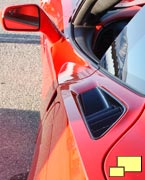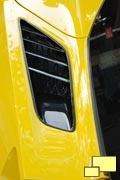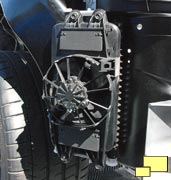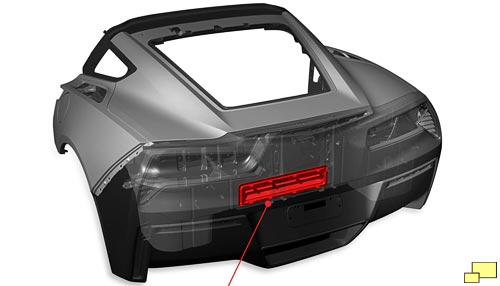Corvette Generations:
C1 C2 C3 C4 C5 C6 C7 C8
Corvette: Year by Year
1953 1954 1955 1956 1957 1958 1959 1960 1961 1962 19631964 1965 1966 1967 1968 1969 1970 1971 1972 1973 1974
1975 1976 1977 1978 1979 1980 1981 1982 1983 1984 1985
1986 1987 1988 1989 1990 1991 1992 1993 1994 1995 1996
1997 1998 1999 2000 2001 2002 2003 2004 2005 2006 2007
2008 2009 2010 2011 2012 2013 2014 2015 2016 2017 2018
2019 2020 2021 2022 2023 2024 2025
Corvette C7 Technology Part 2
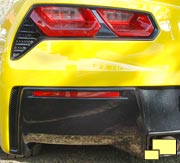 Unlike some of the past Corvette iterations, the various vents on the C7 are functional and well thought out. Above left and middle: air intake mounted above the rear wheels. Above right: Transmission cooler located on the drivers' side. Z51 equipped Corvettes have a similar cooler for the e-LSD differential on the passenger side.
Unlike some of the past Corvette iterations, the various vents on the C7 are functional and well thought out. Above left and middle: air intake mounted above the rear wheels. Above right: Transmission cooler located on the drivers' side. Z51 equipped Corvettes have a similar cooler for the e-LSD differential on the passenger side.
Right: Air exits via vents located near the tail lights and the rear fascia.
Calculating the Difference
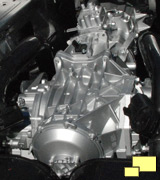 A smart electronic limited-slip differential (eLSD) is included in the Z51 Performance Package and continuously optimizes the torque split between the rear wheels. The system features a hydraulically actuated clutch that can infinitely vary clutch engagement and can respond from open to full engagement in tenths of a second. It shifts torque based on a unique algorithm which factors in vehicle speed, steering input and throttle position to improve steering feel, handling balance and traction.
A smart electronic limited-slip differential (eLSD) is included in the Z51 Performance Package and continuously optimizes the torque split between the rear wheels. The system features a hydraulically actuated clutch that can infinitely vary clutch engagement and can respond from open to full engagement in tenths of a second. It shifts torque based on a unique algorithm which factors in vehicle speed, steering input and throttle position to improve steering feel, handling balance and traction.
The eLSD is fully integrated with StabiliTrak and Performance Traction Management systems. Its calibrations vary among three modes, based on the Drive Mode Selector setting:
- Mode 1 is the default setting for normal driving and emphasizes vehicle stability
- Mode 2 is engaged when electronic stability control is turned off in the Sport or Track Driver Modes. This calibration enables more nimble turn-in and traction while accelerating out of a corner
- Mode 3 is automatically selected when Performance Traction Management is engaged. This calibration has the same function as Mode 2, but is fine-tuned to work with Performance Traction Management.
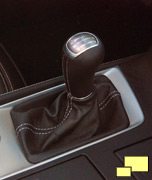 The main justification for the seven speed transmission seems to be to make the specifications look good and to improve fuel economy. The gears are ridiculously tall which is one of the reasons the C7 does not suffer the indignity of a gas guzzler tax. Engine revs at 70 MPH is a decidedly lazy 1,500 RPM. Test reports say that top speed is actually achieved in fifth gear; going to sixth or seventh will slow things down as there is insufficient power at the lower engine revs to push the air out of the way. The non ZR1 C6 generation six speed Corvettes told the same story; their top speed was obtained in fifth gear.
The main justification for the seven speed transmission seems to be to make the specifications look good and to improve fuel economy. The gears are ridiculously tall which is one of the reasons the C7 does not suffer the indignity of a gas guzzler tax. Engine revs at 70 MPH is a decidedly lazy 1,500 RPM. Test reports say that top speed is actually achieved in fifth gear; going to sixth or seventh will slow things down as there is insufficient power at the lower engine revs to push the air out of the way. The non ZR1 C6 generation six speed Corvettes told the same story; their top speed was obtained in fifth gear.
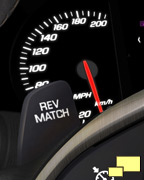 Active Rev Match (ARM) is included with every manual transmission 2014 Corvette. It works by matching the engine revs (up to 5,400 RPM) to the anticipated engine revs for the selected gear and road speed before the clutch is engaged. The system is normally off and is activated by the paddle switches on both sides of the steering wheel and does not operate if the accelerator pedal is applied. The system is controversial amongst some drivers who feel that it isn't necessary with proper driving techniques and that manual rev matching could become a lost art with such systems. Advantages do include potentially better reliability along with reduced warranty claims, something that will make the GM bean counters happy.
Active Rev Match (ARM) is included with every manual transmission 2014 Corvette. It works by matching the engine revs (up to 5,400 RPM) to the anticipated engine revs for the selected gear and road speed before the clutch is engaged. The system is normally off and is activated by the paddle switches on both sides of the steering wheel and does not operate if the accelerator pedal is applied. The system is controversial amongst some drivers who feel that it isn't necessary with proper driving techniques and that manual rev matching could become a lost art with such systems. Advantages do include potentially better reliability along with reduced warranty claims, something that will make the GM bean counters happy.
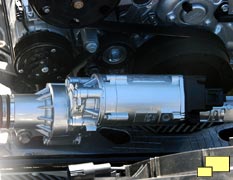 Much of the credit for the excellent road manners of the C7 Corvette goes to the new electric power steering which offers assist based on driving conditions and the driver selected mode (Sport, Touring or Track). There's a variable ratio system accomplished by the spacing of the teeth on the steering rack. GMs claim of an overall increase in steering system stiffness is believable; it now feels more direct and solid with zip amounts of play and excellent on center feel. The result can make amateur and occasional track participants (in other words, most of us) faster sooner but probably won't affect pro drivers.
Much of the credit for the excellent road manners of the C7 Corvette goes to the new electric power steering which offers assist based on driving conditions and the driver selected mode (Sport, Touring or Track). There's a variable ratio system accomplished by the spacing of the teeth on the steering rack. GMs claim of an overall increase in steering system stiffness is believable; it now feels more direct and solid with zip amounts of play and excellent on center feel. The result can make amateur and occasional track participants (in other words, most of us) faster sooner but probably won't affect pro drivers.
The electric power steering pump system has other advantages that include (slightly) better fuel economy, along with better reliability. With no hydraulic fluid and one less thing for the accessory belt to accommodate, you can add simpler maintenance to the list.
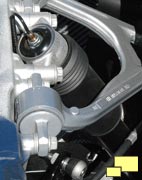 The Magnetic Selective Ride Control (RPO FE4: $1,795) shock absorber system was upgraded to a dual coil system for the C7. It is a direct relative of the Magnetic Selective Ride Control (RPO F55; $1,695.00) introduced in the 2003 Corvette and is an evolutionary form of Active Handling technology research from the early 1990s. For 2014 it is only available on Z51 equipped Corvettes although that could change in the future. The new dual coil system offered faster response time (not that anyone complained about the slow response time of the previous system) due to - in engineering speak - reduced eddy currents. A faster computer system enabled damping force changes up to 1,000 times per second.
The Magnetic Selective Ride Control (RPO FE4: $1,795) shock absorber system was upgraded to a dual coil system for the C7. It is a direct relative of the Magnetic Selective Ride Control (RPO F55; $1,695.00) introduced in the 2003 Corvette and is an evolutionary form of Active Handling technology research from the early 1990s. For 2014 it is only available on Z51 equipped Corvettes although that could change in the future. The new dual coil system offered faster response time (not that anyone complained about the slow response time of the previous system) due to - in engineering speak - reduced eddy currents. A faster computer system enabled damping force changes up to 1,000 times per second.
The advantages of FE4 and previous MR (as the Magnetic Selective Ride Control came to be known as) systems was to offer daily driver comfort and a race track competitive suspension in the same car.




